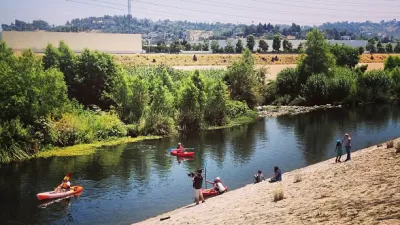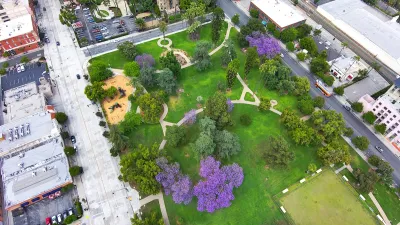Researchers have made a positive link between increased greenery in a child's neighborhoods and a reduction in aggressive behavior.

Researchers from the University of Southern California have identified the contribution that nature can play in reducing aggressive behavior in adolescents and teenagers. Reporting in Pacific Standard, Tom Jacobs writes that the study of over 1,200 children between the ages of 9 and 18, from 640 families in Los Angeles found that close proximity of green space to the children's homes resulted in less aggressive behavior.
“We found strong evidence supporting the benefits of neighborhood green space in reducing aggressive behaviors,” the researchers write. “The results of our adjusted analyses suggest a consistent pattern of decreased aggression associated with increasing residential green space within a 1000-meter buffer.”
They found no evidence this impact was limited to wealthier or poorer neighborhoods, and report it still held true after accounting for such factors as traffic density and proximity to freeways.
The study concludes that there is a clear benefit to mental health from interacting with natural environments, whether through providing access to areas for physical activity, reducing an area's ambient noise, or reducing pollution levels.
FULL STORY: Teenagers Surrounded by Green Are Less Aggressive

Study: Maui’s Plan to Convert Vacation Rentals to Long-Term Housing Could Cause Nearly $1 Billion Economic Loss
The plan would reduce visitor accommodation by 25,% resulting in 1,900 jobs lost.

Alabama: Trump Terminates Settlements for Black Communities Harmed By Raw Sewage
Trump deemed the landmark civil rights agreement “illegal DEI and environmental justice policy.”

North Texas Transit Leaders Tout Benefits of TOD for Growing Region
At a summit focused on transit-oriented development, policymakers discussed how North Texas’ expanded light rail system can serve as a tool for economic growth.

San Diego County Sees a Rise in Urban Coyotes
San Diego County experiences a rise in urban coyotes, as sightings become prevalent throughout its urban neighbourhoods and surrounding areas.

Los Angeles County Invests in Wildfire Recovery for Parks, Trails, and Open Space
The $4.25 million RESTORE Program supports the recovery of parks, trails, and open spaces damaged by the January 2025 wildfires through targeted grants that promote community healing, wildfire resilience, and equitable access to nature.

Nevada Bills Aim to Establish Home Insurance Assurance Amidst Wildfire Risk
Republican sponsor hopes the FAIR plan would be “a true market of last resort.”
Urban Design for Planners 1: Software Tools
This six-course series explores essential urban design concepts using open source software and equips planners with the tools they need to participate fully in the urban design process.
Planning for Universal Design
Learn the tools for implementing Universal Design in planning regulations.
Alamo Area Metropolitan Planning Organization
City of Santa Clarita
Institute for Housing and Urban Development Studies (IHS)
City of Grandview
Harvard GSD Executive Education
Toledo-Lucas County Plan Commissions
Salt Lake City
NYU Wagner Graduate School of Public Service





























